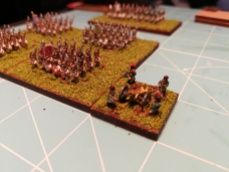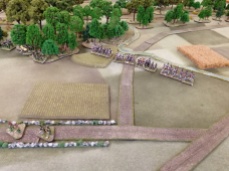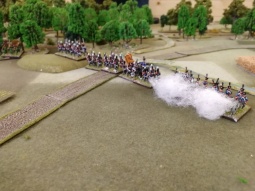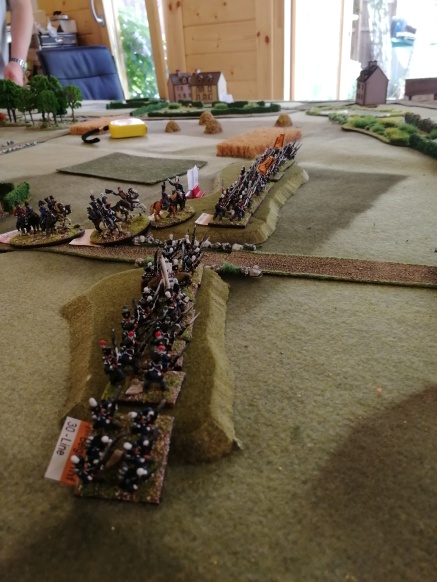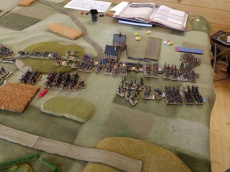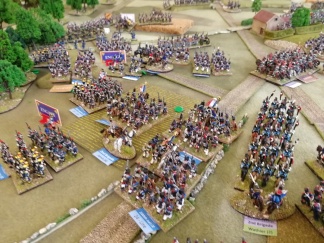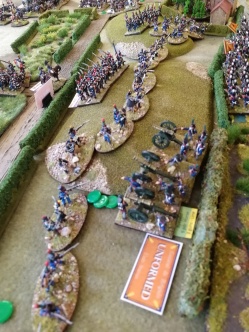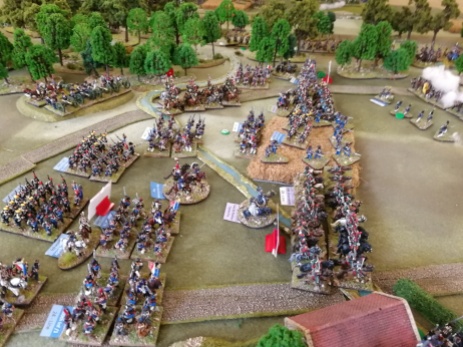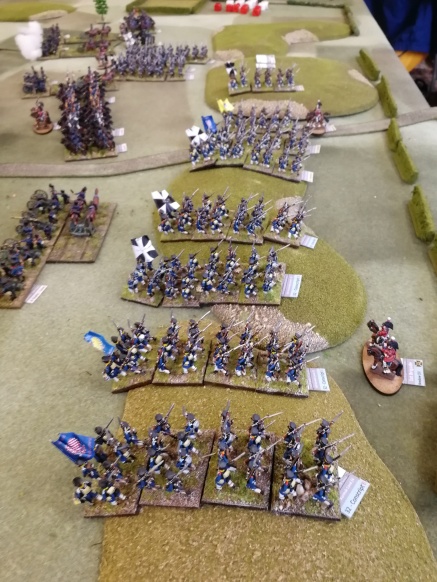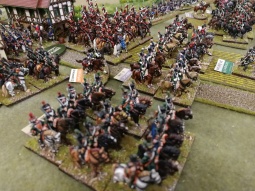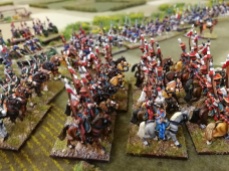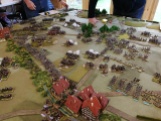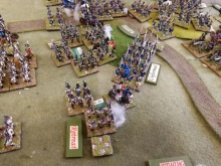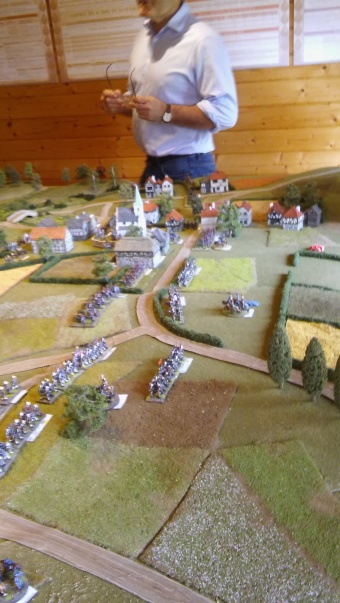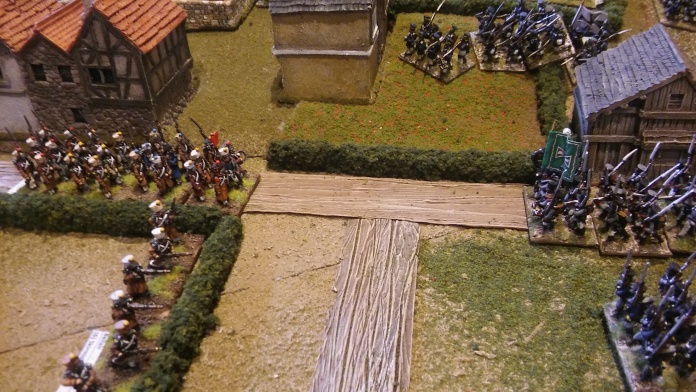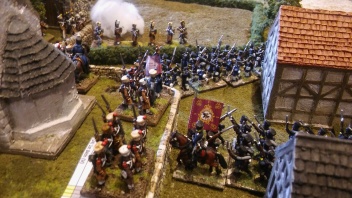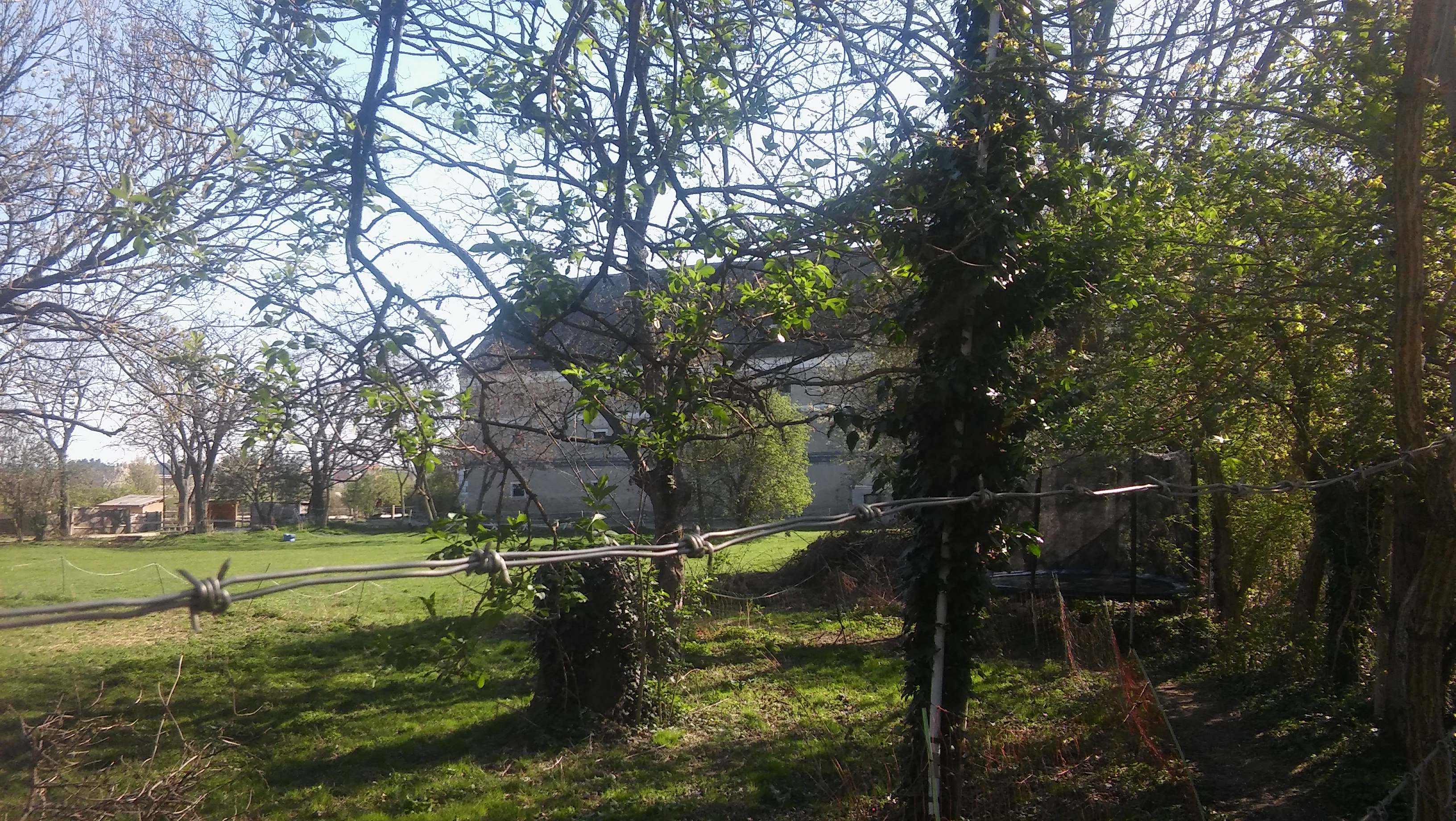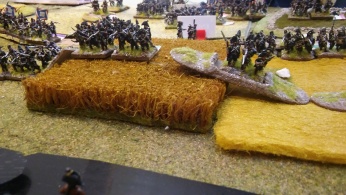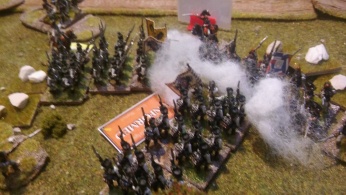There were two firsts for me in this game put on by Ian on Monday. First game of 6mm Napoleonics and it would be the first time I’ve ever commanded Russians so I was really looking forward to it.
The scenario was nice and straight forward, the Russians had to advance and secure a village that commanded a gap in the line of hills that the French were in possession of. To do this I had under command an Infantry Division, a Grenadier Division and a Brigade of Light Cavalry, my Infantry Division had a battery of 12 guns and the Cavalry had a battery of 6 guns attached. The French were in about a Division in strength with no visible Cavalry.
My plan was quite simple. Des would take the advanced guard consisting of the Jager and Cavalry Brigades with the Horse Artillery and engage the French in the village and on the hills on the right. I would take the rest of the Infantry Division (2 Brigades of 4 btlns each) and take the hills to the left where the French forces looked weaker, I could then roll the position up from that side. Ian would take his Grenadiers (once they arrived) and support the Jager, they were also to be the reserve in case any problems arose or to deal the coup de grace once my attack had developed. The French were led by Andy and Martin and, as mentioned, seemed to have the bulk of their forces either in the village or on the hills to the right – both of their batteries were posted in these locations too. On the left flank it seemed as if they only had a couple of battalions and no artillery which augured well for my planned attack on this side of the field.
So we commenced and Des immediately sent the Hussars and Uhlans of his Cavalry Brigade off to the right to engage the French posted on the hills to pin them in place. The Horse battery went with the horse hoping to cause discomfort to any squares that were formed and, if possible, to enable the cavalry a chance to charge home. His Jager Brigade advanced gallantly towards the village, throwing out a screen of skirmishers as they went consisting of a company from each battalion. I started my advance on the left when I arrived on the field and then the French started some long range artillery fire against Des’ command which resulted in some casualties due, no doubt, to Andy’s famous blue ‘devils dice’ that always roll well (a 9, 10, and a couple of 11’s wasn’t it Des?).
This slideshow requires JavaScript.
Apart from a message from Ian telling me that his Grenadiers were going to be delayed a while things seemed to be developing well, Des had forced the French infantry on the hill to either form square or retire and his Horse battery had commenced battering one square that guarded the flank of the battery there. The Jager had started trading shots with the garrison of the village and the French suffered a setback when Andy’s dice failed him (allegedly because Martin had used them) and came up with snake-eyes when rolling for the battery in the village which meant that they were now low on ammo. Over on my side of the field I was having to pass through the defile caused by the woods but my advance rolled on even though it was slowed down a tad. I also dispatched half of my guns to the Jager to help take on the French batteries.
This slideshow requires JavaScript.
It was about this time when a large cloud of dust appeared behind the village which by its volume and could only mean one thing, French cavalry had arrived. Never mind, we would stick to the plan as it seemed to be going ok, indeed Des now launched his Hussars against the decimated French square hoping to break it and carry on onto the battery behind. Unfortunately this didn’t come off quite as planned, the French infantry did break and retreat but the Hussars bounced back to the Russian guns enabling the French guns to make their escape. The French cavalry then put in an appearance, moving to counter the Russian horse, with one of their Dragoon regiments starting a charge up the hill which the Uhlans countered with a charge of their own the result of which was that both units refused to contact each other! A cloud of dust could be seen moving rapidly across the rear of the French position to the left flank so it was obvious that the French had another brigade of cavalry. Things had started to look a bit more difficult for us, however, the Grenadiers had now arrived and were marching rapidly to the front to support the Jager.
This slideshow requires JavaScript.
The French then seemingly became emboldened with both the failure of the Russian cavalry to charge home and the arrival of their own heavies. The battery that had retired on the hills returned to their position and began taking the Jager under fire again, the heavy cavalry brigade then started a series of advances and charges that didn’t give the Russian horse time to rally and effectively took them out of the action, pushing them further and further back. I had finally reached the hills to the left of the village and as my first Brigade advanced to engage the retiring French infantry my second Brigade started to march around the extreme flank of the enemy position.
It was now that the French infantry from the hills on the right and the village assaulted the Jager to their front, who had been suffering from artillery fire, before the grenadiers arrived to reinforce them. This attack was carried out with the usual French elan and it succeeded in pushing the Jager back. I then discovered that the French did indeed have another Cavalry brigade and had to stop the outflanking manoeuvre of my second brigade and put them into square. At the same time my lead battalion in my first brigade was forced to retreat due to a devastating volley from two French battalions and I was having trouble making the other battalions charge home, (couldn’t manage to change the brigade orders to assault).
This slideshow requires JavaScript.
So things had not turned out so well for us: the cavalry was in full retreat on the right pursued by French cavalry, the infantry attack on the left flank was stymied by the presence of the other French cavalry brigade and our inability to close with the bayonet on the weak French infantry. It all hinged on us breaking through in the centre. The French infantry attack here had caused the artillery to retreat and did manage to break a Jager battalion and force the remainder back. However, the Grenadiers were finally in position and they launched a counter attack on the lead French battalion, surely this would see us embark on a glorious counter attack that would sweep the enemy from the field. Alas, it was not to be and so with that final throw of the dice failing we decided that there was no use continuing with the attack, we would have to try again another day (we had run out of time too!).
All in all it was a great game. Things were in the balance for a while, I really did think we were going to win for most of the game and it is the small margins that decided the outcome: taking the French battery on the hills, being able to assault the infantry on the left, not having two brigades of heavy cavalry turn up, that sort of thing. As usual it was a pleasure playing with the gents and an absolute joy to be using Ian’s 6mm kit, very nice indeed and does suit Napoleonics so well. Thanks all round.


















































































